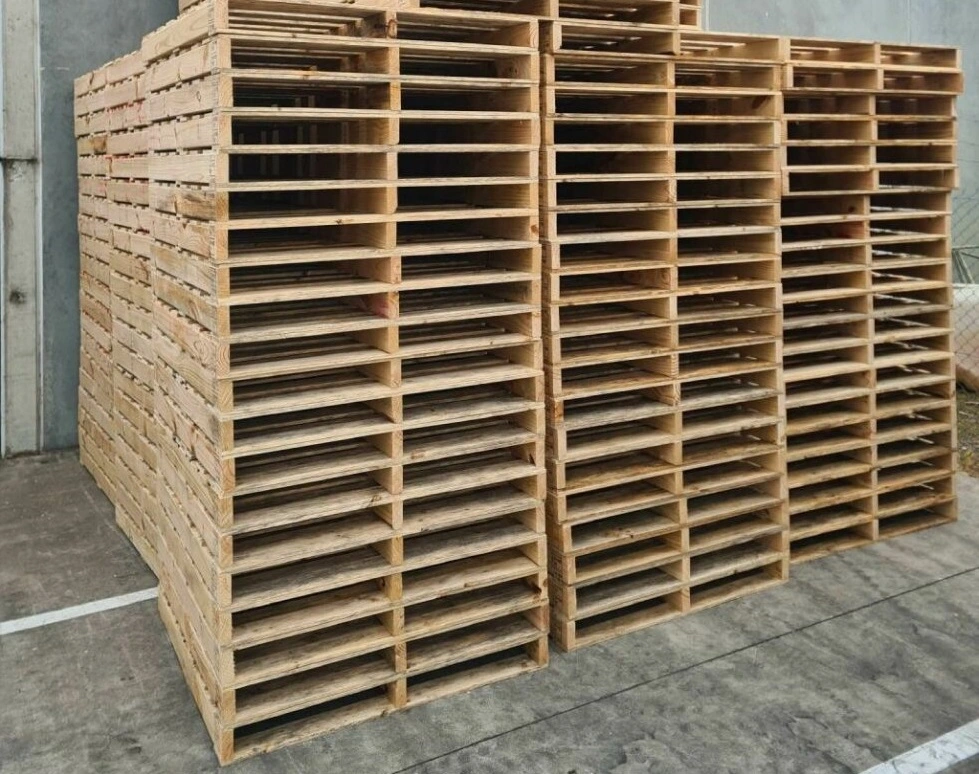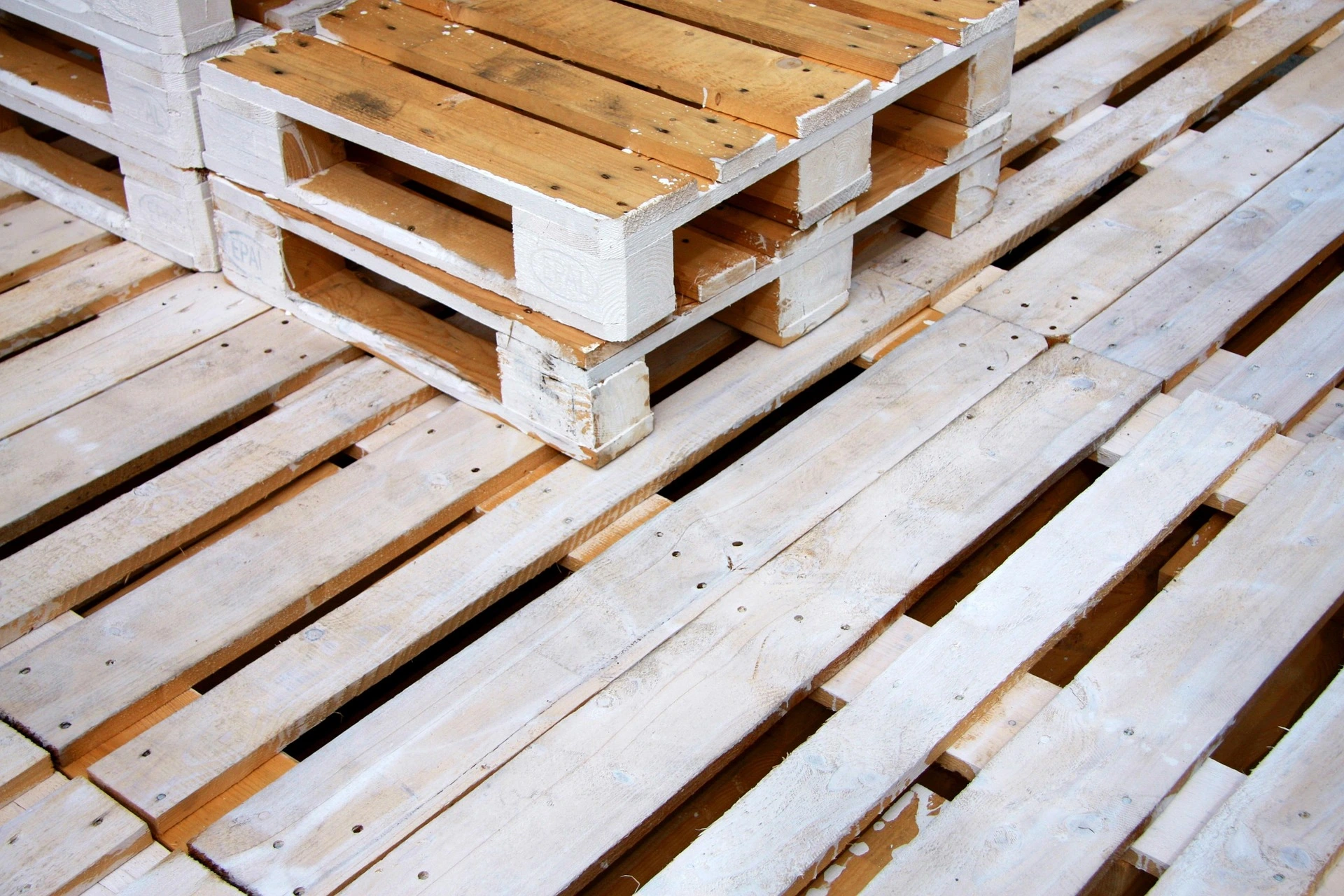At a glance:
- Proper pallet storage and handling protect staff, reduce product damage, and keep operations compliant with safety standards.
- Storage methods include pallet racking systems for optimal usage of vertical space and floor/block stacking for quick and flexible product access arrangements.
- Choosing the right location, stacking safely, and following fire safety guidelines reduce the risk of workplace accidents and product damage.
- Best practices for handling pallets include using appropriate equipment, avoiding manual lifting, training staff, and wearing safe PPE.
- Regular inspections, clear aisles, a safety-first culture, and pallet rotation extend pallet life and support smooth warehouse flow.
Wooden pallets are a vital part of daily warehouse operations. However, when they’re stored or handled poorly, they can become safety hazards, cause product damage, and slow down productivity. Storing and handling pallets correctly protects your team, preserves product quality, and keeps your operation running smoothly and efficiently.
An organised pallet system enhances operational efficiency by enabling faster access, a smoother workflow, and fewer bottlenecks. In addition, storing and handling pallets aligning with workplace safety regulations ensures compliance and helps businesses avoid costly penalties.
Businesses that implement best-practice pallet handling can also achieve cost savings by reducing pallet damage, lowering replacement expenses, and preventing downtime caused by accidents or blocked access.
In this article, let’s understand how to store wooden pallets safely in your warehouse and how to handle them.
How to Store Wooden Pallets Safely in Your Warehouse
Now that you have understood why proper storage and handling matter, let’s look at how to implement safe and efficient storage practices.
Choose the Right Storage Method
When planning pallet storage, the first step is to select a method that balances space efficiency, accessibility, and safety. Racking and block stacking are two widely popular methods.
Pallet Racking Systems
Pallet racking system involves a strong, steel storage framework to hold pallets on multiple levels, using beams or shelves for secure placement. This setup allows forklifts to place or retrieve pallets individually without disrupting other pallets. It maximises vertical space and is optimal for warehouses with high ceilings.
Common options include selective racks for varied goods, drive-in racks for high-volume, low-SKU storage, push-back racks for medium-turnover items, and cantilever racks for oversized loads.
Advantages of pallet racking systems:
- Maximises cubic storage capacity by using vertical space
- Improves accessibility, reducing handling time and avoiding the need to restack pallets
- Supports safer storage by removing the instability risks of free-standing stacks
Limitations of pallet racking systems:
- Requires precise forklift operation and regular inspections to identify rack damage
- Involves a higher upfront investment and must meet strict load-bearing and installation safety standards
The best approach is to choose a rack type that suits your inventory turnover and product mix. For example, use selective racks for varied goods that need frequent access, drive-in racks for storing high volumes of a few SKUs, and push-back racks to maximise space for medium-turnover items.
For operations that use racking, Waterstone’s racking pallets deliver the same strength and stability while fitting seamlessly into racking systems when required.
Floor or Block Stacking
Floor stacking, also known as block stacking, is a simple and cost-effective storage method in which pallets are arranged in dense, grid-like formations directly on the warehouse floor, without racking.
Stacks are built by placing pallets on top of each other to a safe, recommended height. They may require support frames depending on their size and stability. This method is secure and efficient when pallets are in good condition, uniform in size, and stored on level flooring.
Advantages of floor stacking:
- Quick to set up with minimal upfront investment
- Flexible layout that can be easily reconfigured as storage needs change
- Well-suited for short-term storage or fast-moving pallets, especially when handling bulk quantities of similar goods
Limitations of block stacking:
- Consumes more floor space and limits vertical capacity compared to racking
- Access to lower pallets requires unstacking upper layers, slowing retrieval and making stock rotation harder
- Stability depends heavily on even flooring, correct stacking techniques, and not exceeding safe stack heights
The best practice is to use block stacking on level floors, place heavier pallets at the bottom, and follow safe stacking height guidelines to prevent collapse. When storing large batches of uniform goods, this method can also maximise floor space efficiency.
Choose the Right Location/Storage Conditions
The storage location and conditions have a direct impact on pallet safety and lifespan. Keep them away from heat sources to prevent warping, drying out, or creating fire risks.
A dry storage environment is equally important, as it reduces the risk of mould growth, rot, and weakening of timber fibres. Position pallets away from walls and machinery to improve airflow, deter pests, and reduce the risk of collision damage from moving equipment.
For warehouses in humid climates, ensure there is adequate ventilation to prevent moisture build-up, which can weaken pallet strength and durability. However, it won’t do much if you choose pallets that have high moisture content..
That’s why it’s essential to select heat-treated pallets, or dry timber pallets, especially if you export goods. Heat treated pallets, are processed to meet International Standards for Phytosanitary Measures No. 15 (ISPM 15) standards. Complying with this regulation helps protect products from moisture damage, pests, and microbial growth right from the start.
Read More: Understanding ISPM 15 Standards for Wooden Pallets
Follow Safe Stacking Practices
Proper stacking of pallets is essential for stability and preventing accidents. Therefore, ensure every pallet is positioned right-side-up and start stacking on a smooth, level surface. Additionally, keep stacks within safe height limits based on load capacity, stability guidelines, and warehouse safety compliance to protect both your products and your staff.
Place heavier pallets at the bottom of the stack to prevent crushing or tipping. Using an interlocking stacking technique can stop pallets from leaning or collapsing, while the addition of spacers or pallet collars can improve stability for taller stacks.
To ensure stability further, group similar pallets. For example, always stack standard pallets (1165 mm × 1165 mm) together, or Euro pallets (1200 mm × 800 mm) with other Euro pallets. Avoid mixing pallets of different types or dimensions, as this creates instability and increases the risk of collapse.
Follow Fire Safety Guidelines
Fire safety is a critical part of any pallet storage plan. To minimise fire risks, maintain a clear space between pallet stacks and sprinkler systems to ensure water can reach every area in the event of a fire. Additionally, store empty pallets well away from production zones to reduce fire hazards in high-risk areas.
Furthermore, conduct regular reviews, follow local fire codes, and understand pallet quantity limits and layout requirements in your facility to ensure compliance.
How to Handle Wooden Pallets
Safe handling is just as important as secure storage. Using the right equipment and providing proper staff training minimises the risk of damage and injury, while keeping warehouse operations efficient.
Let’s explore some best practices for handling wooden pallets safely.
Use Appropriate Equipment
Handling pallets safely starts with using the correct equipment for the task. Operators should only run forklifts and pallet jacks when the load is stable and the equipment can handle the pallet’s weight.
For wrapped or sensitive loads, clamp trucks are an ideal choice. Using the right attachments, such as specific forks or handling accessories, helps prevent damage to pallets or products during movement.
Avoid Manual Handling
Wherever possible, avoid lifting wooden pallets by hand. At 15 to 30 kg each, they can quickly become a serious injury risk. Instead, use mechanical aids like conveyors, lift tables, or pallet dispensers to protect your team from strain and keep operations running smoothly.
Train Staff in Safe Handling
All warehouse staff must be trained in best practices, including correct fork positioning and load stability checks. In addition, they must be able to identify damaged pallets or unsafe stacks before moving them and when to remove them from service. Clear emergency procedures should be in place to guide staff in the event of pallet collapse, fire, or workplace injury.
Staff should wear personal protective equipment (PPE) at all times when handling pallets. PPE includes gloves to prevent splinters, safety boots to protect against dropped loads, and high-visibility clothing in busy areas. In noisy environments and those prone to airborne debris, staff should also use hearing protection and safety glasses, respectively.
Additional Storage and Handling Tips
The following simple practices can make a big difference to pallet longevity, workplace safety, and regulatory compliance.
Inspect Pallets Before Storage: Inspect each pallet for loose boards, protruding nails, or signs of structural damage before storage. Remove any damaged pallets from usable stock and direct them for repair or recycling.
Keep Aisles and Emergency Exits Clear: Never allow pallet stacks to block aisles or emergency exits. Clear access keeps goods moving efficiently and ensures you meet WHS and fire safety obligations.
Prioritise Safety: Use clear safety signage and markings to indicate load limits, stacking areas, and hazard zones. Warehouse supervisors should conduct regular checks to confirm that staff are following safe storage and handling practices, keeping the warehouse compliant with all safety regulations.
Pallet Rotation: Implement a First In, First Out (FIFO) rotation system to prevent pallets from deteriorating in storage. Seasonal reviews should be carried out to inspect and rotate pallets stored for extended periods.
Safe storage and handling of wooden pallets protect staff, safeguard goods, maintain compliance, and streamline warehouse operations. From storing the pallets correctly to training staff, every step plays a role in preventing accidents, reducing costs, and maximising efficiency.
Whether you use pallet racking or floor stacking based on your requirements, be sure to back it with safety checks and regular inspections.
Not sure how to optimise your pallet storage and handling? Contact Waterstone Pallets today for expert advice and reliable wooden pallet solutions that enhance safety, compliance, and efficiency in your warehouse operations.
FAQs
What is the safest way to store wooden pallets in a warehouse?
Use a storage method suited to your space and inventory. Pallet racking is best for long-term, high-volume storage, while floor or block stacking works for short-term use if pallets are in good condition and stacked evenly. Keep them in a dry, ventilated area, away from heat, with clear forklift access.
How high can I safely stack pallets?
Follow pallet condition, load weight, and safety regulations. Generally, floor stacks shouldn’t exceed four to six pallets high, with heavy pallets at the bottom and interlocked for stability. In racking, stick to the manufacturer’s load and height limits.
What should I do if pallets are damaged upon inspection?
If a pallet has severe damage and poses a safety risk, it should be replaced immediately. However, if the damage is minor, repairing is a cost-effective solution. You can reach out to reliable businesses like Waterstone Pallets for repair services.



